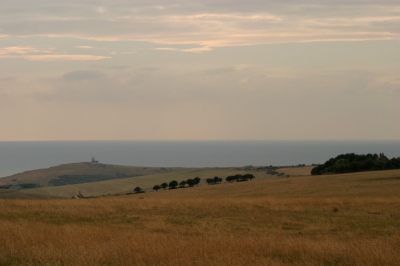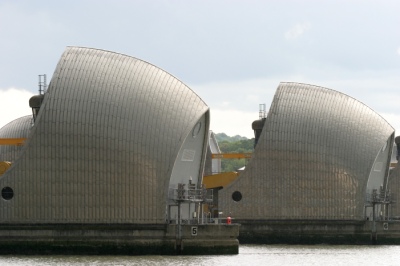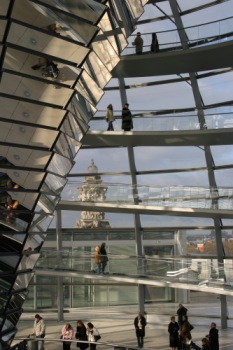Colin's Journal: A place for thoughts about politics, software, and daily life.
October 29th, 2006
FC6
Fedora always comes with at least one significant problem. Looking back I’d say that FC5 was probably the smoothest install – only tracking down the right version of the wireless firmware proved difficult. My favourite user-unfriendly Fedora moment was having to manually type in kernel boot parameters, just in order to enable the media integrity check during installation. FC6 gives this not-been-tested-prior-to-release bug a run for it’s money.
 Having learnt from previous experiences I went with a full installation of Fedora Core 6 rather than an upgrade. Problems encountered:
Having learnt from previous experiences I went with a full installation of Fedora Core 6 rather than an upgrade. Problems encountered:
- During installation several packages couldn’t be read from the CD. Selecting re-try a few times solved the problem, but for a moment I thought I’d be stuck without a usable machine.
- When I logged in I found that the CPU was pinned at full speed.
- Searching for files in Nautilus doesn’t work.
The cpuspeed problem turned out to be caused by Fedora installing a 586 rather than 686 kernel. I had to uninstall the 586 version (plus dependencies), and then install the 686 version. This left the GRUB bootloader configuration broken. It took several attempts at manual configuration using the rescue disk to get this fixed.
The lack of search in Nautilus is caused by beagle not working. Removing beagle (and re-starting Nautilus) has solved that particular problem.
Overall Fedora remains a distribution only usable by the Linux savvy. I’ve yet to see a Linux installation that’s flawless, but the nature of the problems (and ease with which they are worked around) indicates to me that the biggest barriers remain quality of testing rather than any fundamental technical problem.
Image: Three sheep from the Lake District village of Cartmel.
August 13th, 2006
Visiting the coast
 It was a good day out despite the weather. Setting off in late morning I started the drive to the coast in drizzle and grey skies. As I got hungry I kept an eye out for somewhere to eat, plumping for a nice looking pub in Tunbridge Wells. The Weavers has both a restaurant and bar menu, with interesting sounding food hosted on both. I went with a jacket potato, topped with sausage and chili jam and accompanied by a salad. It’s an unusual combination, but it worked well, in part thanks to the balance provided by the salad, particularly the olives.
It was a good day out despite the weather. Setting off in late morning I started the drive to the coast in drizzle and grey skies. As I got hungry I kept an eye out for somewhere to eat, plumping for a nice looking pub in Tunbridge Wells. The Weavers has both a restaurant and bar menu, with interesting sounding food hosted on both. I went with a jacket potato, topped with sausage and chili jam and accompanied by a salad. It’s an unusual combination, but it worked well, in part thanks to the balance provided by the salad, particularly the olives.
After lunch I pushed on to Eastbourne where the weather broke and became a mixture of sunshine and showers for the rest of the day. The pebble beach was fairly quiet, with most people sticking to the promenade. Although the pier dominates the water front I was more interested in getting to the views of the south downs that lie further west.
The next stop before returning home was Beachy Head, which provides great views of Eastbourne and a sharp contrast to the seaside town. The South Downs at this point are extremely windswept with the few trees around bent over in the prevailing wind.
We are now planning our summer trip. The basic aim is to drive north, spending some time in the Lake District before getting into Scotland. We’ll only have a week, so need to plan carefully to avoid spending too many days doing solid driving. There’s two B&B / Restaurants in the Lake District that we are interested in, so we should be able to get to at least one of them. My only particular target in Scotland is to find some good scenery to photograph and visit Edinburgh.
May 29th, 2006
Weather and such
 For the past two weekends running it’s been wet and grey outside. Today was an exception – this afternoon the sky turned mostly blue and we had some warm sunshine in the slightly nippy air. I’ve been meaning to go down to the Thames barrier ever since we passed it on the way to London City Airport.
For the past two weekends running it’s been wet and grey outside. Today was an exception – this afternoon the sky turned mostly blue and we had some warm sunshine in the slightly nippy air. I’ve been meaning to go down to the Thames barrier ever since we passed it on the way to London City Airport.
The Thames barrier has its own park and is easily accessible from the Pontoon Dock stop of the DLR. It’s only twenty minutes or so from our flat, so I grabbed my camera this afternoon and headed that way. By the time I turned up the last of the sunlight was fading and a dark grey sky had formed. Within moments of me arriving at the bank of the Thames we had the first speckles of rain, followed shortly by lightening, thunder, hail and heavy rain. All of which is a long winded way of saying that I didn’t get many shots of the barrier in a good light.
As the state of my journal shows I’m struggling to motivate myself into writing these days. I’ve got a few ideas for posts, mainly related to Agile and Offshore working practises, but haven’t yet taken the time to pen them. Hopefully taking off next week will help – and let me get some good summer pictures around Toronto.
Image: Thames Barrier shortly before a downpour.
April 8th, 2006
Printing
Today I tackled an outstanding issue with our home computer setup – my inability to print.
 Last year we bought a Canon iP4200 printer as our replacement for the Epson left in North America. The printer is pretty good; it handles duplex printing, has reasonably priced ink, and when setup to print photos does a very acceptable job indeed. The only downside was lack of a Linux printer driver, other than the commercial TurboPrint.
Last year we bought a Canon iP4200 printer as our replacement for the Epson left in North America. The printer is pretty good; it handles duplex printing, has reasonably priced ink, and when setup to print photos does a very acceptable job indeed. The only downside was lack of a Linux printer driver, other than the commercial TurboPrint.
One work around for this was to have the printer connected to a MacOS X machine and shared over the network. Fedora Core 5 can see MacOS X shared printers on the network and can print to them as if they are a postscript printer. In practise this didn’t work without setting up an entry in the /etc/hosts file so that the hostname of the machine hosting the printer could be found.
Today I tried to figure out why FC5 couldn’t use Zeroconf to discover the address of the MacOS X machine instead of having to manually setup the /etc/hosts file. The answer is fairly straight forward: FC5 is missing the nss-mdns library which provides this functionality. Thankfully it’s easy to get hold of and configure this, something I’ve documented in “Zeroconf in Fedora”. Having sorted this out I can now print directly over the network.
In a piece of additional good news, Canon have made available an iP4200 printer driver for Linux. It’s not currently publicised anywhere on their European support website, but can be found directly on their Japanese ftp site.
To use these drivers install the following files:
- cnijfilter-common-2.60-1.i386.rpm
- cnijfilter-ip4200-2.60-1.i386.rpm
- cnijfilter-ip4200-lprng-2.60-1.i386.rpm
To make the driver available during printer configuration go into the Printing administration tool (Desktop -> Administration -> Printing) and select “Import PPD…” from the “Action” menu. The file to import is canonip4200.ppd in /usr/share/cups/model/. The printer driver will now appear as “IP4200 (PPD)” in the list of Canon drivers during printer setup.
January 23rd, 2006
Fixing faults
 Software has a curious property, in that it never decays or weathers, and yet requires maintenance to be useful. If you install a new program, it may stop an existing program from working. If you try to open a recently produced Word document into an old version of Word, it may fail to load. If a piece of software held opinions, it would see this as a an environmental change.
Software has a curious property, in that it never decays or weathers, and yet requires maintenance to be useful. If you install a new program, it may stop an existing program from working. If you try to open a recently produced Word document into an old version of Word, it may fail to load. If a piece of software held opinions, it would see this as a an environmental change.
Software maintenance is the opposite of physical world maintenance. In the physical world you replace the bits that are damaged, the broken pane or the cracked paving stone. In software maintenance you take code that hasn’t changed, and alter it to suit a new environment.
Stories have the same maintenance property. Books may decay over time, but if the words are carefully copied from one book to another without error, the story itself will remain unchanged. However a changed environment can cause faults in our understanding or appreciation of a story. Stefan Geens ponders whether the manner of story telling will return to that of the Greek myth. Does a modern audience appreciate a world of restricted communication, or do they have more in common with Greek gods?
Over a year ago, I decided to stop maintaining my own RSS/Atom aggregator. Although I’ve not been making fixes since then, I had continued to use it out of nothing but momentum. Over the year various bits of other software on my machine has been upgraded, and the Atom file format has evolved into a 1.0 specification. As a result several problems started to appear in TALAggregator, and I’ve finally decided to stop using it. I’m now getting used to the Sage feed reader extension for Firefox, software that is actively maintained and developed.
January 1st, 2006
The end of 2005

Quote of the day “I cannot imagine achieving anything meaningful over a 45-minute lunch.” – Alejandra Moore, a communications consultant.
In the first half of 2005 I did little travel. In the second half, particularly from November onwards, I’ve been dashing off all over the place. It started in mid-October with a week long trip to Pune for work. It was my first time in India, and I greatly enjoyed it. The food was generally good, with a couple of restaurants really standing out. Getting around town in the evenings in the motor-rickshaws is fast, cheap, and exciting/dangerous. Getting to work in the morning and getting back in the afternoon takes a while, bouncing along in the back of a four wheel drive van.
Two weeks after getting back from Pune we went to Paris for a weekend, my first time there, and only my second trip on the Eurostar. Starting in the middle of one city and ending in the middle of another is a huge advantage; I could leave work at the normal time, and when we returned our delays in arriving into London meant only a short taxi ride to get home. Paris itself was a lot of fun, though we’ve only scratched the surface of the city.
Berlin was next, also an excellent trip (the architecture was particularly interesting as much of the city has been rebuilt after the war), but marred slightly upon return due to the Stanstead “Express” (45 mins) being replaced by a coach (1hr – and you’re still only at Liverpool Street), not fun at 1am. Berlin was my first trip to Germany in three years, and so it was a strange coincidence that I needed to go to Frankfurt later that same week for work (of which I saw very little).
Two days after getting back from Frankfurt I was off to Pune again, another enjoyable trip at a much more relaxed pace. Exactly a week after getting back from Pune, it was off to Toronto. The reason for the trip was Shana’s defence, although we also got some time to relax and visit friends. We got back on the 18th of December, and then headed to Venice for our Christmas break on the 22nd.
I don’t normally do New Year’s resolutions – but I think I need to try and spread out our travel commitments more.
Photo: Notre Dam Cathedral hiding behind trees.
August 21st, 2005
Bluetooth power
 I recently bought a Jabra 250v bluetooth headset for use with my mobile phone. For the last few days I’ve been frustrated with the very poor battery life that both the headset, and my phone (Sony Ericsson T610) have shown. Today I finally figured out what the problem was, and I’m sure others have made the same mistake.
I recently bought a Jabra 250v bluetooth headset for use with my mobile phone. For the last few days I’ve been frustrated with the very poor battery life that both the headset, and my phone (Sony Ericsson T610) have shown. Today I finally figured out what the problem was, and I’m sure others have made the same mistake.
After pairing my headset with the phone I selected the headset and then “Connect” to establish the link between them. This was my mistake! After pairing the phone will automatically make the connection to the headset when an incoming or outgoing call is made. When a call comes in you can answer by pressing the headset button, or by using the phone and then pressing the headset button during the call to transfer to the handsfree. When you make a call the phone automatically establishes the connection to the headset if it is in range.
By manually selecting “Connect” for the headset I was using the headset like it was in one long continuous phone call, hence leading to a very short “standby” battery life on both the headset and the phone.
In other respects I’ve been very happy with the Jabra 250v. It’s light, much more stylish than most of the competition, and fits comfortably despite my glasses. Now that I’ve figured out the battery life problem I can get on with enjoying the benefits of it.
I’m sure others have made the same mistake with bluetooth headsets. Hopefully this post will save someone, somewhere, the same puzzlement over the battery life.
The photo is of St. Albans Cathedral.
August 9th, 2005
Bits and bobs
 Living in London means I make great use of TFL’s Journey Planner. Although typing in street and station names on a mobile phone is a time consuming exercise, I’ve even had the need to use their WAP based version while out and about. Today I added their Java mobile tube map to my phone. While it’s slow to start on a T610 (nearly a minute!), it’s a useful addition for when you have no phone signal or just want to see the tube map. What I really need however is a mobile London street map. Even one that just allowed searches and didn’t know where I was would be a great boon.
Living in London means I make great use of TFL’s Journey Planner. Although typing in street and station names on a mobile phone is a time consuming exercise, I’ve even had the need to use their WAP based version while out and about. Today I added their Java mobile tube map to my phone. While it’s slow to start on a T610 (nearly a minute!), it’s a useful addition for when you have no phone signal or just want to see the tube map. What I really need however is a mobile London street map. Even one that just allowed searches and didn’t know where I was would be a great boon.
On Sunday I went skating in Hyde Park. Although there were more people milling around than on the Toronto water front, the paths are generally wider and easier to skate on. There were a lot of other skaters around, including a whole group dancing on skates – very impressive. I’m happy to report that my skating skills haven’t deteriorated much in the year or more since I last used them. That’s doesn’t say much though, and my stamina is terrible.
I’ve released a new version of SimpleTAL, the first since February. There’s been a few patches building up that I wanted to get out, and it was about time I implemented Iterator support.
Even without a functioning synchronisation program for my laptop, backing up my phone is still very easy. Just send the whole phone book via bluetooth, and then import it into Evolution so that I’ve got a copy of everyone’s number. It would still be nicer to have synchronisation with the individuals contact details, but I’ve never managed to get that working.
The photo is an old one, taken in a city far far away.
July 10th, 2005
Mobile Virtual Network Operators
Yesterday I had to get a phone for Shana, entailing a shopping trip around Tottenham Court Road. I had decided to get a phone on the same network I use (Orange) in order to lower costs when calling each other. Orange’s selection of pre-pay phones, however, is small and dated. I considered moving to a contract in order to get a better phone, but their costs are high (minimum of £19 per month) and don’t offer much discount to the cost of their better phones.
Virgin on the other hand have a good selection of modern phones, all at reasonable prices. Their call rates are generally lower than Orange, especially for texting (3p between Virgin phones, 12p between Orange phones). It quickly became obvious that getting a phone on Virgin made the most sense – and that’s exactly what I did.
 I had already bought a Virgin phone back at Christmas, but was using my old pre-Toronto Orange SIM. With Shana on Virgin it made sense for me to move to the same network, so I called up Orange for my PAC to allow my existing number to be moved to Virgin. When I called Virgin their porting team were busy, so they offered to call me back as soon as they were available, which they did just 10 minutes later. I get to keep my existing number and take advantage of lower call rates – exactly what number portability was intended to provide.
I had already bought a Virgin phone back at Christmas, but was using my old pre-Toronto Orange SIM. With Shana on Virgin it made sense for me to move to the same network, so I called up Orange for my PAC to allow my existing number to be moved to Virgin. When I called Virgin their porting team were busy, so they offered to call me back as soon as they were available, which they did just 10 minutes later. I get to keep my existing number and take advantage of lower call rates – exactly what number portability was intended to provide.
Some in the telecommunications industry underestimate the significance of MVNOs like Virgin. The argument runs that, as these companies own no network capacity, they are essentially just marketing companies who’s only asset is their brand.
This analysis ignores two other value propositions that MVNOs have access to. Firstly MVNOs are buying capacity from ordinary mobile providers in large volumes, and so they have tremendous pricing power. When a with-network mobile provider needs to reduce costs they have to do this the hard way – streamlining their OSS systems and processes, putting pressure on their network kit vendors, etc. An MVNO has an easier task, they simply shop around to the other network providers and through this negotiate lower rates.
The second source of value for an MVNO is customer service. Once network access is secured and their operating prices set, the only way for them to increase margins is to improve operational effectiveness. With no network to run, all their management effort can be spent on improving customer service.
My move to Virgin isn’t driven by their marketing or brand. They offer better phones, lower call prices, and good service. Dismissing the MVNOs as marketing shells is a mistake.
Photo taken on a recent walk around Silverdale, Lancashire.
June 19th, 2005
Hot spam
It’s a hot day here in London. The sun has set and the cool night air should be helping, but it’s still 29C outside. The rest of the week doesn’t look like being any cooler, with the daily temperatures significantly above the historic 20.2C average high for June. Conditions like this make me miss the air conditioning we had in Toronto.

Evolution’s integration with SpamAssassin makes flagging email as spam exceptionally easy. The default configuration does leave something to be desired however. When a user flags an email as being spam they expect future emails with the same content to be automatically moved to the junk mail folder. The default SpamAssassin rules require a spam score of 5 before an email is flagged as being spam, and the bayes rule (which learns what content counts as spam) alone isn’t enough to give such a score. To solve this I’ve increased the score that the bayes rule gives for email it calculates as being almost certainly spam, by putting the following rule into the .spamassassin/user_prefs file:
score BAYES_95 0 0 4.514 4.514
score BAYES_99 0 0 5.000 5.000
Hopefully this will lead to a significant drop in the amount of junk email that I have to flag manually each day.
The picture is of a fountain in Kensington Gardens, taken a week ago.
Software
The full list of my published Software
Email: colin at owlfish.com
